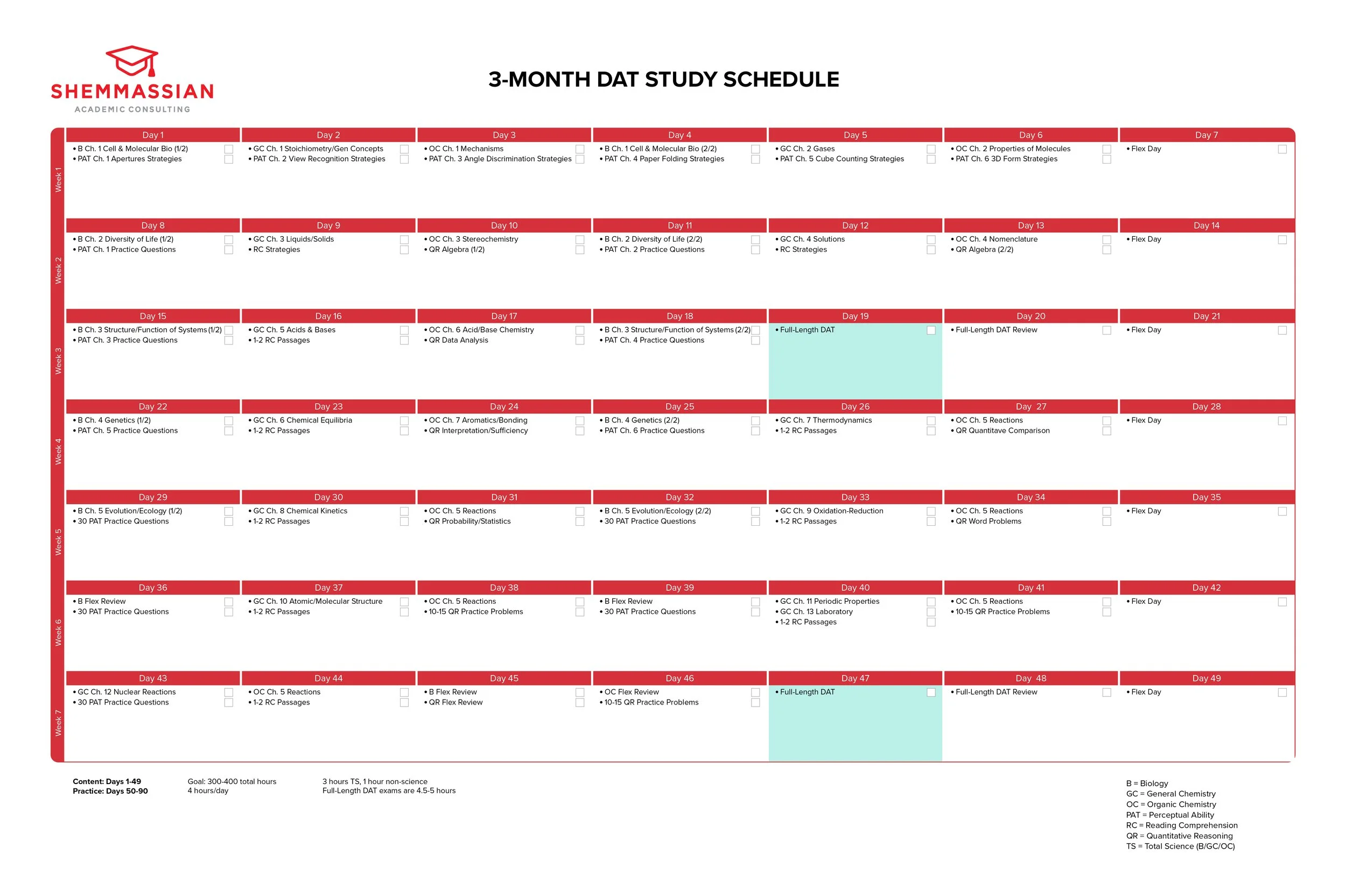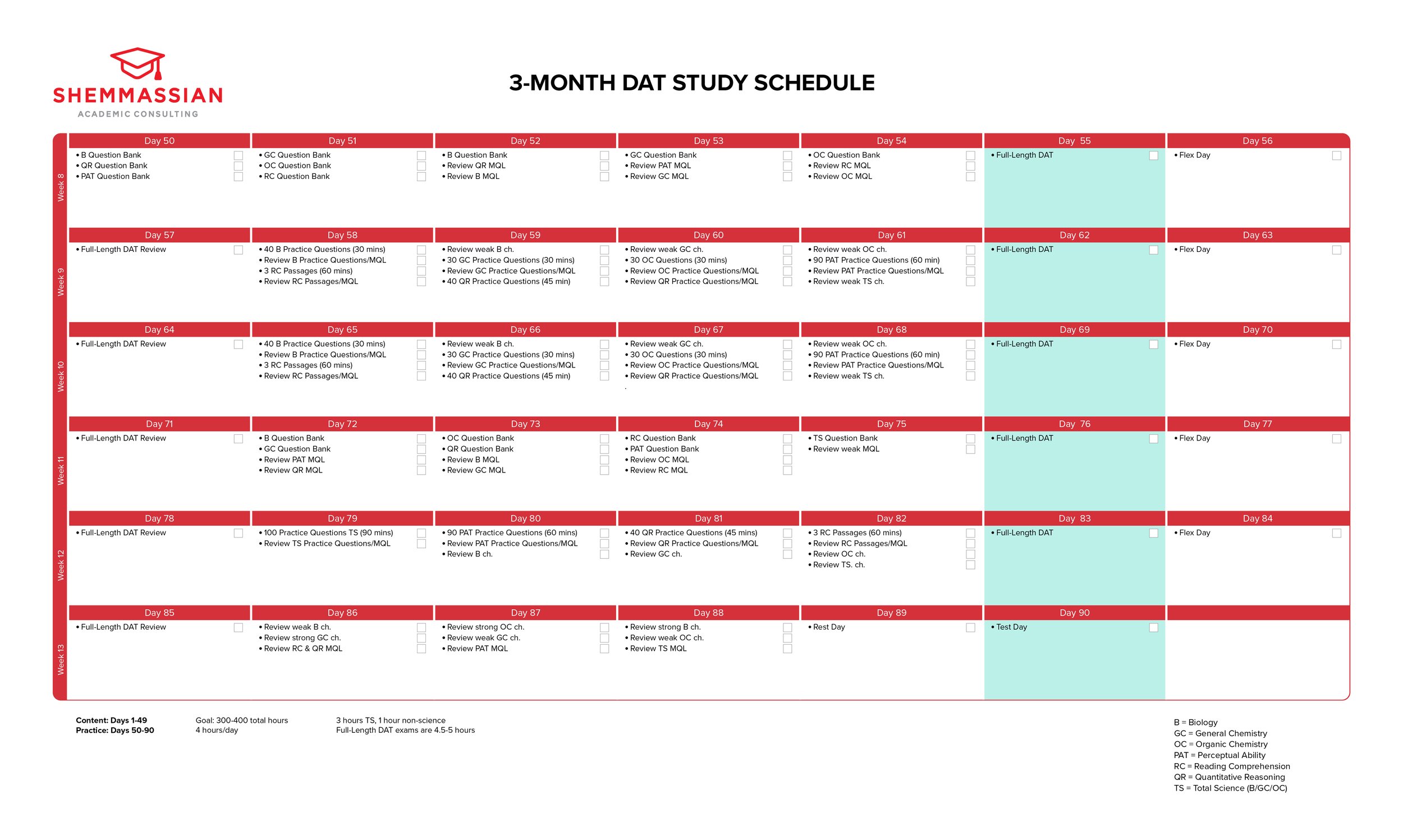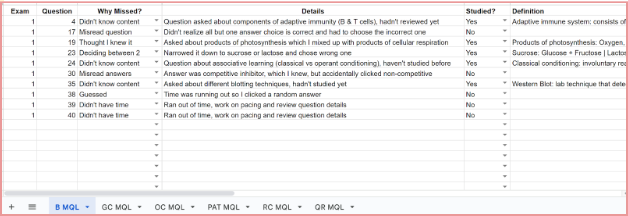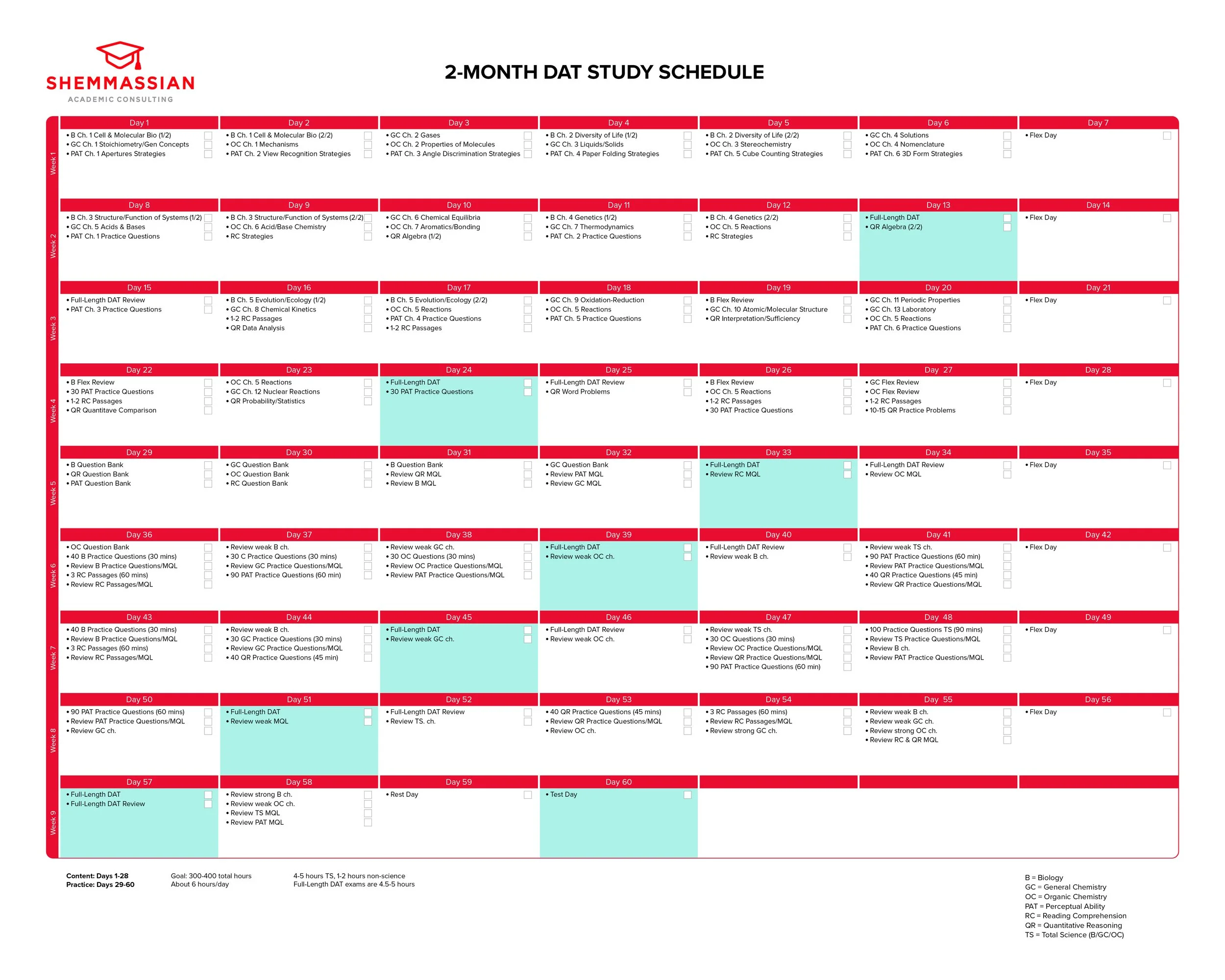The Ideal DAT Study Schedule (1 Month, 2 Months, 3 Months, 4 Months)
/Proven DAT study schedule templates to help you score 23+, regardless of the time you have to prepare
----
Part 1: Introduction to building the ideal DAT study schedule
You likely know that the Dental Admission Test (DAT) is one of the biggest hurdles to becoming a dentist and that your score on the exam, along with your GPA, make up your dental school application “stats.”
You might be thinking, “I attend a prestigious school and have a high GPA, how much can a low DAT score possibly hurt me?”
After all, would admissions committee members really value your score on one exam—taken on a single day—as much as your GPA or extracurricular profile, which are developed over the course of years?
Or perhaps you have a lower GPA and are wondering if you still have a chance to get into dental school with a high DAT score.
The DAT is used as a standardized measure to make dental school admissions decisions. It compares your academic readiness with your peers’, regardless of where you attended school or your GPA.
While a high score can boost your odds of getting in, a low DAT score can sink your application, even if you have a high GPA from a prestigious school.
If you’re feeling overwhelmed by taking the DAT, we understand.
That said, with proper preparation, we know you can score a 23+ and get accepted to dental school, because we’ve seen it on numerous occasions.
The most important aspect of preparing for the DAT is creating and following an effective study schedule, one that outlines the high-yield topics you’ll study each day and when you’ll take practice exams.
It will serve as a roadmap that will take you from day one to test day while helping you avoid unhelpful detours and keeping you accountable.
You should spend at least an hour or two creating your study schedule because it will save you massive amounts of time en route to reaching your goal score.
This guide will teach you how to create the ideal DAT study schedule so you can maximize your learning and crush the DAT.
(Suggested reading: The Ideal Dental School Application Timeline)
What this DAT study schedule guide covers
Given the importance of having a clear game plan heading into the exam, we developed a comprehensive guide to developing a great DAT study schedule that covers the following:
A step-by-step walkthrough to creating your own DAT study plan, including choosing a test date and planning each week until your exam.
Example study schedules for 1, 2, 3, and 4 months.
Frequently asked questions about the DAT study schedule.
Strategies for staying on task.
----
Part 2: A step-by-step approach to building a DAT study schedule
Step 1: Choose your DAT test date
The first step to conquering the DAT is selecting a test date, and these questions will help you choose the right one:
When do you plan to apply to dental school? Dental school applications open at the beginning of June each year, and you’ll want to complete your exam before then.
Have you completed the necessary classes covering DAT subjects? General chemistry I & II, organic chemistry I & II, and introductory biology are all tested on the DAT and are prerequisites for dental school. Other helpful courses include human physiology, genetics, and plant and animal science.
What daily time commitments do you have that will impact your availability to study?
(Suggested reading: DAT Test Dates: A Complete Summary (Score Release Timeframe Included))
Looking for premium DAT content resources to ace the exam? Click here to access our full suite of comprehensive DAT guides.
Gain instant access to the most digestible and comprehensive DAT content resources available. Subscribe today to lock in the current investments, which will be increasing in the future for new subscribers.
Studying for the DAT is a big commitment, and you need to dedicate significant time to prepare well. The steps below will help you figure out how much time you should study each week.
Select your test date.
Identify all of your other commitments between now and your chosen test date, such as:
Classes
Exams (incl. study time)
Work
Volunteering/Shadowing
Personal time
Holidays
Family
Having considered each of these time constraints, determine the average number of hours you can spend preparing for the DAT each week.
If 300 total hours is the minimum amount of time you should devote to your DAT, divide that by the number of weeks until your test date.
For a 12-week study schedule, this would be 25 hours per week, or at least 3.5 hours each day. If you want to study less during the week and more during the weekends, you can adjust your schedule as needed. You may also have more than 12 weeks to study or be on a tighter schedule.
Regardless of the time you have to prepare, you’re in the right place. This guide will walk you through creating a 1-, 2-, 3-, and 4-month study schedule, as well as how many hours you should study per day in each different phase of preparation.
Step 2: Create your DAT study schedule: Content phase
After selecting a date to take the DAT, outline topics to study each day. You should split your DAT prep into two phases, with the first phase focused more heavily on content and the second phase focused more on practice.
If you have 3 months to study for the DAT, the first 6-7 weeks will be content-heavy, with roughly 70% of your time focused on content review and 30% on strategy and practice. Here’s an example of the first 7 weeks of a 3-month study schedule:
three-month dat study schedule weeks 1-7
You can use this study schedule as is, or adapt it to whatever DAT prep materials you’re using. If you choose to create your own schedule, be sure to include some of the features found in the example study schedule.
Each subject area should be studied in parallel. For example, you study chapter 1 for biology, chemistry, and organic chemistry over the first three days, rather than three straight days of the same subject. Studying in parallel will help you better remember what you learned at the beginning of your study schedule come test day.
This study plan is built around the benchmark of 300 total hours, or 3-4 hours each day. About 3/4 of your time each day should be spent studying science content, with the other 1/4 dedicated to perceptual ability (PAT), reading comprehension (RC), or quantitative reasoning (QR) content.
Your total science score may only make up half of your “academic average” (i.e., overall DAT score), but science covers much more content and requires more memorization than the other sections and should be your top priority during the content phase.
An important note about the content phase is the focus on strategy for the PAT and RC sections. For the first week of PAT and RC study, you should learn effective strategies for these sections. After that, there isn’t much content to be studied, as these sections don’t require you to memorize details. Therefore, your time will be spent practicing PAT questions and RC passages while determining what strategies work best for you.
Despite the content-heavy focus of the first phase, you’ll still take two full-length exams during this period. These exams will help you discover what content you need to review while helping to build your testing stamina early on.
A “flex day” is built into each week of the schedule. Studying for the DAT can be taxing, and rest is important to avoid burnout. You can use these flex days as rest days, or you can choose to review content you’ve studied each week.
There are also subjects listed as “flex review.” This flex review allows you to catch up on any content you may not have finished studying during the previous week, or can be used to review more difficult material.
Step 3: Create your DAT study schedule: Practice phase
The second phase of your DAT study schedule will be focused on practice, with about 3/4 of your time spent practicing and 1/4 spent reviewing content. This practice will include five full-length DAT exams, smaller practice tests for each subject, and question banks.
Here’s the second half to the 3-month study schedule that was shown earlier:
three-month dat study schedule weeks 8-13
Looking through this example, you can see that there is a lot of time built in to review practice tests or missed question logs (MQLs), which are critical for DAT practice.
Simply taking exams and skimming through the questions you got wrong or guessed on is good prep, but really understanding each answer choice will help you prepare even better. The MQL is how you’ll keep track of all the questions you miss, whether via spreadsheet or other document.
For example, let’s say you took a biology practice exam and saw the following question:
Which type of cells are found in the small intestine?
a) Chief cells
b) Goblet cells
c) Parietal cells
d) Acinar cells
You can’t quite remember, so you incorrectly answer chief cells (c). After completing the practice exam, you see that the correct answer is goblet cells (b).
On your MQL, you should record this question and a definition for each of the answer choices. In this example, you would write where chief, goblet, parietal, and acinar cells are located. Then, when it’s time to review the MQL, you’ll be reminded of not only why you missed the question, but also the definition of each of the incorrect options. Your MQL may look something like this:
example mql
This example DAT schedule includes some other features that will help when building your own study plan. Just like the content phase, the practice phase has a built-in flex day. This flex day is usually scheduled the day after full-length exams, which last around 4.5 hours. You should use this day to rest and recharge.
The next study day after each full-length test is focused on a full-length review. During this review, you should look back through every question, making note on your MQL of any questions you missed or didn’t fully understand.
This review should take about the same amount of time as the test itself. Reviewing your full-length exams is crucial because it shows you what areas you need to keep working on and helps you learn from your errors so you won’t make the same mistakes on the actual exam.
The week before taking the DAT, be sure to review some of your stronger topics. It’s likely that you haven’t reviewed them in a while, and you want to make sure that you don’t have any lapses on the easier content.
A rest day is scheduled the day before taking the DAT. With test day so close, you’re likely to feel some nerves. The purpose of this rest day is to help you reset and ensure that you’re physically and mentally prepared for your exam. You’ve spent so much time preparing and should be confident going into your exam.
Step 4. Update your DAT schedule
After you’ve completed your DAT study schedule and followed it for a while, you may notice that some things aren’t quite working for you.
Maybe you aren’t getting through as much content as you planned to, or perhaps you’re completing each day’s tasks with time to spare. Whatever it might be, your schedule may need to be adjusted.
Don’t be afraid to spend some time updating your study plan. If you’re feeling overwhelmed by the amount of content to cover, it’s much better to take a step back, refine your schedule, and create a plan than give up because you fell behind.
Take advantage of the flex reviews by scheduling any topics you didn’t get to. By updating your schedule, you’ll ensure that your schedule is personalized to your understanding.
If you need to reschedule your test, you can do so up to 24 hours before. There’s a rescheduling fee that increases the closer you get to test day. If you must reschedule, it’s best to do so early.
----
Part 3: DAT study schedule templates
----
1-month DAT study schedule
If you only have 1 month to prepare for the DAT, you should aim to study 8-10 hours each day, and perhaps more.
Even though time will be scarce, it’s still possible to do well. When studying content, you should focus on breadth over depth; in other words, being familiar with many topics will serve you better than knowing a few topics in-depth.
Additionally, spend adequate time taking practice exams. Taking and reviewing practice exams is one of the fastest ways to identify your weaknesses and areas that need improvement.
dat study schedule Template (1 month)
Our Select Plan (10 hours of live tutoring) for 1:1 DAT tutoring will help you identify topics to focus on. During this 4-week period, we will:
Work with you to create a customized day-to-day schedule based on your current time commitments, previous DAT experience, and available resources.
Identify the most high-yield topics to review.
Help you eliminate your bad study habits—especially the ones you don’t know you have—while doubling down on what’s working for you in the short time remaining.
You may be thinking that there isn’t enough time to refine or change your study strategies. And while the best time to get good help was yesterday, today is the next best.
DAT Select Plan (10 Hours)
----
2-month DAT study schedule
With 2 months to study for the DAT, you should aim for 5-6 hours per day.
If you have two months to study for the DAT, we recommend signing up for our Superior Plan. This plan includes 25 hours of customized, 1:1 DAT tutoring.
dat study schedule Template (2 month)
During this 2-month period, we will:
Create an individualized 2-month schedule built around your commitments like school, work, and extracurriculars.
Help direct your study to high-yield topics that will have the highest impact on your score.
Develop (or refine) strategies that work for you when it comes to understanding perceptual ability and reading comprehension questions
DAT Superior Plan (25 Hours)
----
3-month DAT study schedule
The 3-month study schedule puts you in the “sweet spot” of having enough time to prepare well while not scheduling your DAT too far off. Following a 3-month schedule, you should aim for 3-4 hours of study per day.
With 3 months of prep time, the Superior+ Plan (40 hours of live tutoring) is a great fit for individualized, 1:1 DAT tutoring.
dat study schedule Template (3 month)
During your 3-month study period, we will:
Work with you to create a daily study plan unique to your schedule and help you stay accountable
Review high yield content that frequently shows up on the DAT
Develop an individualized strategy with you to help with all sections of the DAT
DAT Superior+ Plan (40 Hours)
----
4-month DAT study schedule
Following the 4-month study schedule, you should aim for 2-3 hours of study per day. Having 3 to 4 months to study is ideal because you have adequate time to focus on testing strategies and content.
dat study schedule Template (4 month)
If you have more time to devote to studying for the DAT, our Top Scorer Plan (60 hours of live tutoring) for 1:1 DAT tutoring is the optimal choice. With several months available (approximately four to six months), we’re positioned to:
Create an individualized study plan that ensures you take into account your own school, work, and personal activities (including holidays and time for relaxation). By setting you up for success from the outset, you’re better equipped to reach your study goals.
Learn all DAT content that you need to know.
Establish a customized strategy based on empirical data during the content review phase so you’ll enter the practice phase feeling confident about your ability to conquer the exam.
DAT Top Scorer Plan (60 Hours)
----
Part 4: Strategies for staying on task
Here are some additional strategies from our experienced tutors to help improve your productivity:
Consider where you’re studying. Do you frequently study in an environment conducive to learning? Are you studying in a dorm where roommates are frequently interrupting you, a noisy coffee shop, or a quiet library?
The place you choose to study plays a big role in how effective your study time is and how well you retain information. You should choose a quiet place to study where you can focus well. If you’re struggling with burnout, consider switching up your study spots.
Minimize distractions. Distractions can come from other people or the outside world, but can also be your own doing. Your phone can be one of the biggest distractions to completing your study schedule, whether due to social media, games, etc.. Consider using features or apps to limit distractions or leaving your phone in your backpack during study time.
Utilize proven study techniques. One popular study strategy is the Pomodoro technique. To study more effectively, you set a 20-30 minute timer. For the duration of the timer, you study intensely with no breaks or distractions. When the timer goes off, you rest for 5-10 minutes before beginning the study timer again.
By following this study technique, you get a large dose of extreme concentration paired with a mental rest to give your brain a chance to absorb the new information. This technique is effective because it breaks up large periods of time and information into manageable study sessions.
Looking for premium DAT content resources to ace the exam? Click here to access our full suite of comprehensive DAT guides.
Gain instant access to the most digestible and comprehensive DAT content resources available. Subscribe today to lock in the current investments, which will be increasing in the future for new subscribers.
Final thoughts
Preparing for the DAT can be daunting, given its importance in applying to dental school and the breadth of information it covers. By creating an effective study schedule, you can prepare well for the DAT and achieve your highest score.













